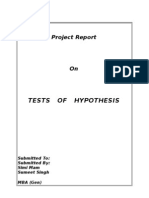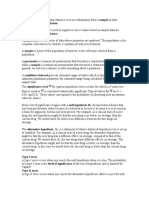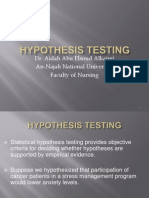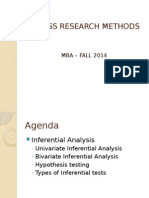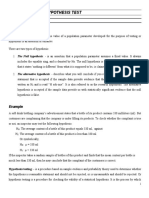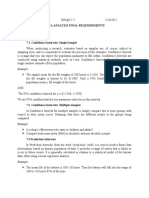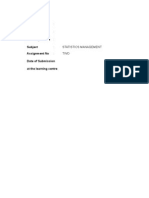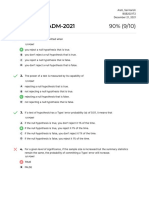Hypothesis Testing Part I
Hypothesis Testing Part I
Uploaded by
Abi AbeCopyright:
Available Formats
Hypothesis Testing Part I
Hypothesis Testing Part I
Uploaded by
Abi AbeOriginal Description:
Original Title
Copyright
Available Formats
Share this document
Did you find this document useful?
Is this content inappropriate?
Copyright:
Available Formats
Hypothesis Testing Part I
Hypothesis Testing Part I
Uploaded by
Abi AbeCopyright:
Available Formats
Chapter 8: Hypothesis Testing P a g e | 113
CHAPTER 8
HYPOTHESIS TESTING
Introduction
A statistical test of hypothesis is a fairly clear-cut procedure that enables an
experimenter to either reject or accept null hypothesis with measure risks 𝛼 𝑎𝑛𝑑 𝛽.
The experimenter can control the risk of falsely rejecting the null hypothesis by
selecting an appropriate value of 𝛼. On the other hand, the value of 𝛽depends on the
sample size and the values of the parameter under the test that are of practical
importance to the experimenter. When this information is not available, an
experimenter may decide to select an affordable sample size, in the hope that the
sample will contain sufficient information to reject the null hypothesis. The chance
that this decision is in error is given by 𝛼, whose value has been set in advance. If
the sample does not provide sufficient evidence to reject 𝐻0 , the experimenter may
wish to state the results of the test as “The data do not support the rejection of 𝐻0 ”
rather than accepting the 𝐻0 without knowing the chance of error 𝛽.
A hypothesis is a conjectural statement of the relation between two or more
variables. Hypotheses are always declarative sentence form, and they relate either
generally or specifically.
According to Deveza (1996), the following are the criteria of “good” hypotheses and
hypotheses statements:
1. Hypotheses are statements about the relations between variables.
2. Hypotheses carry clear implications for testing the stated relations.
These two criteria mean that hypothesis statements contain two or more variables
that are measurable or potentially measurable and that they specify how the
variables are related.
A research hypothesis is a predictive statement that represents a very specific
proposed answer to the problem statement. Hypotheses should be stated in an
empirically testable form, and should indicate the specific nature of the connection
between or among variables that was initially identified in the problem statement.
Statistics and Probability by SMAGalman
Chapter 8: Hypothesis Testing P a g e | 114
Types of Hypothesis
1. Null Hypothesis (𝐻𝑜 ) is primarily used for statistical purposes. It is the hypothesis
to be tested and it represents what the investigation doubts to be true.
2. Alternative Hypothesis (𝐻𝑎 ) states the nature of the connection between or
among variables that we expect on theory and/or prior research. In other words, it
is the operational statement of the theory that the experimenter or researcher
believes to be true and wishes to prove.
The alternative hypothesis is a statement that contradicts or disagrees with the null
hypothesis. If the null hypothesis is rejected, the conclusion is reflected by the
alternative hypothesis. If there is no enough statistical evidence to reject the null
hypothesis, it is retained, but not accepted. In this case, the null hypothesis is not
necessarily true, but it just cannot be rejected from the current evidence from the
sample data.
Example 1
If we are going to test the correlation of Physics and Mathematics subjects, we
formulate the null and alternative hypotheses as follows:
𝐻0 : There is no significant relationship between students’ academic
performance in Physics and Mathematics subjects
or : Students’ academic performance in Physics and Mathematics are not
correlated.
𝐻𝑎 : There is a significant relationship between students’ academic performance
in Physics and Mathematics subjects
or : Students’ academic performance in Physics and Mathematics are correlated.
Example 2
A computer shop receives a delivery of a big number of laptops from a salesman.
The delivery is regarded as satisfactory if the percentage of defective laptops does
not exceed 3%(i.e., 𝑃 ≤ 3%); otherwise, it is regarded as unsatisfactory. The
percentage of defective sets is an unknown parameter hence, the sampling
inspection is done to decide whether the delivery is to be accepted or rejected. The
following portray the hypotheses of this problem.
𝐻0 : The delivery is satisfactory; i.e., 𝑃 ≤ 0.03
𝐻𝑎 : The delivery is satisfactory; i.e., 𝑃 > 0.03
Statistics and Probability by SMAGalman
Chapter 8: Hypothesis Testing P a g e | 115
Directional and Nondirectional Tests
A test of hypothesis is categorized into two:
a) One-tailed test is also known as the directional test. It occurs when researchers
do not have a priori expectation about the ample value they expect to observe. This
is usually done if the researcher just want to test whether a mean is larger or
smaller the hypothesized population mean.
Figure 8.1
Region of Rejection and Acceptance in One-tailed Test
b) Two-tailed test is also known as the nondirectional test of a hypothesis. It is a
test where alternative hypothesis does not specify a directional difference for the
parameter of interest. It is appropriate when researchers do not have a priori
expectation regarding the value they expect to observe in the sample. The
researchers would simply want to see if the sample mean is different from the
hypothesized population in either direction.
Figure 8.2
Region of Rejection and Acceptance in Two-tailed Test
Statistics and Probability by SMAGalman
Chapter 8: Hypothesis Testing P a g e | 116
Level of Confidence
In hypothesis testing, the conclusion reached is not based on certainty, but
on a probability estimate. This probability estimate or risk of committing an error in
the conclusion is determined by the researcher. This is known as the alpha level.
If we set the alpha level at 5% (𝛼 = 0.05), then we are taking a 5% risk of
being wrong and 95% risk of being right. That is, we have a probability error of 5%
that our conclusion is wrong.
Furthermore, the level of significance determines the critical value of the test
statistic. This value serves as the reference point for rejecting or not rejecting a null
𝛼
hypothesis. In a two-tailed test, the level of significance is given by . For instance, if
2
the indicated level of significance is 5% and the test is a two-tailed test, the level of
significance would be determined by 2.5%.
Types of Errors
Whichever hypothesis is correct. But there is a chance that sampling error
will cause a researcher to reject the hypothesis. We may reject the null hypothesis
that is true or we may accept a null hypothesis that is false. These two types of
mistakes in hypothesis testing are called type I and type II error, respectively.
Steps in Hypothesis Testing
The logical steps that should be followed in order to arrive at an objective
and meaningful result are the following:
1. State the null hypothesis (𝐻0 ).
2. Determine the measurement level of the variables under study. The level of
measurement of the variable determines to a large extent the statistical test the
hypothesis. Parametric tests are generally used for interval and ratio data of
measurement while nonparametric tests are usually applied to nominal and ordinal
types.
3. Choose the statistical test appropriate to test the hypothesis.
4. Specify a significance level and the sample size.
5. Compute the value of a statistical test.
6. Determine the significance of the computed value.
7. Interpret and discuss the result.
Statistics and Probability by SMAGalman
Chapter 8: Hypothesis Testing P a g e | 117
8.1 z-test
This section aims to:
1. determine the conditions when to use the z-test; and
2. test hypothesis using z-test.
This parametric test is used when the given data is population mean and
population standard deviation and 𝑛 > 30. The formula is given by
𝑥̅ − 𝜇
𝑧= 𝜎
√𝑛
Where: 𝑥̅ − 𝑠𝑎𝑚𝑝𝑙𝑒 𝑚𝑒𝑎𝑛
𝜇 − 𝑝𝑜𝑝𝑢𝑙𝑎𝑡𝑖𝑜𝑛 𝑚𝑒𝑎𝑛
𝜎 − 𝑝𝑜𝑝𝑢𝑙𝑎𝑡𝑖𝑜𝑛 𝑠𝑡𝑎𝑛𝑑𝑎𝑟𝑑 𝑑𝑒𝑣𝑖𝑎𝑡𝑖𝑜𝑛
𝑛 − 𝑛𝑢𝑚𝑏𝑒𝑟 𝑜𝑓 𝑠𝑎𝑚𝑝𝑙𝑒𝑠
Use z test when:
• Your sample size should be greater than 30. Otherwise, use a t test.
• Data points should be independent from each other.
• Your data should be normally distributed. However, for large sample sizes
(over 30) this doesn’t always matter.
• Your data should be randomly selected from a population, where each item has
an equal chance of being selected.
• Sample sizes should be equal if at all possible.
Example
In a recent survey of Information Technologists in Nueva Ecija, it was found out that
the average monthly net income of IT experts is P12, 542. Suppose a researcher
wants to test this figure by taking a random sample of 165 IT experts in the province
to determine whether the monthly net income has changed. Suppose further that
the average net monthly income of 165 IT experts is P13,861 and the population
standard deviation was found out to be P1,459. Test the significance at 5% level.
Statistics and Probability by SMAGalman
Chapter 8: Hypothesis Testing P a g e | 118
Solution:
Following the steps in hypothesis testing,
Step 1. 𝐻0 : The average monthly net income of IT experts is still P12, 542
𝜇 = 𝑃12, 542
𝐻𝑎 : The average monthly net IT experts is no longer P12, 542
𝜇 ≠ 𝑃12,542
Step 2. 𝛼 = 5%, two-tailed test (nondirectional)
Step 3. z-test for a single mean
𝑥̅ − 𝜇
𝑧= 𝜎
√𝑛
Step 4. Reject 𝐻0 if the computed z-value is greater than 1.96 or less than -1.96
Step 5. Given : 𝑥̅ = 13,861
𝜇 = 12,542
𝑛 = 165
𝜎 = 1,459
𝑥̅ − 𝜇
𝑧= 𝜎
√𝑛
13,861−12,542
𝑧= 1,459
√165
= 11.61
Step 6. Reject 𝐻0 since 𝑧𝑐 > 1.96.
Step 7. Interpretation: The average monthly income of IT experts is no longer
P12,542.
Statistics and Probability by SMAGalman
Chapter 8: Hypothesis Testing P a g e | 119
Name: ___________________________________________________________ Date: _____________________
Section: _________________________________________________________ Score: ____________________
Exercises 8.1
z-test
1. In the population, the average IQ is 100 with a standard deviation of 15. A team of
scientists wants to test a new medication to see if it has either a positive or negative
effect on intelligence, or no effect at all. A sample of 30 participants who have taken
the medication has a mean of 140. Did the medication affect intelligence, using alpha
= 0.05?
2. The mean Verbal SAT score for the population of first students at NEUST is 520.
The standard deviation of scores in this population is 95. An investigator believes
that the mean Verbal SAT of first year psychology majors is significantly different
from the mean score of the population. The mean of a sample of 36 first year
psychology majors is 548. Please test the investigator's prediction using an alpha
level of .05.
Statistics and Probability by SMAGalman
Chapter 8: Hypothesis Testing P a g e | 120
3. The mean number of close friends for the population of people living in the
Philippines. is 5.7. The standard deviation of scores in this population is 1.3. An
investigator predicts that the mean number of close friends for introverts will be
significantly different from the mean of the population. The mean number of close
friends for a sample of 26 introverts is 6.5. Do these data support the investigator's
prediction? Use an alpha level of .05.
Statistics and Probability by SMAGalman
You might also like
- Chapter 8 of An Elementary Statistics ClassDocument10 pagesChapter 8 of An Elementary Statistics Classricardo2aguilar2castNo ratings yet
- Session 3 With AnswrsDocument14 pagesSession 3 With AnswrsWafa Abdullah100% (2)
- Module 5 - Data Collection Presentation and AnalysisDocument57 pagesModule 5 - Data Collection Presentation and AnalysisChristopher Martin Gunsat89% (19)
- Chapter 8 Hypothesis TestingDocument19 pagesChapter 8 Hypothesis TestingdomingojaynelleNo ratings yet
- Test On Hypothesis For A Single SampleDocument32 pagesTest On Hypothesis For A Single SampleAERONJAY MUÑOZNo ratings yet
- Hypothesis TestDocument15 pagesHypothesis TestS.S.Rules83% (6)
- Q.4. Critically Analyze The Different Procedures of Hypothesis Testing. Ans. Procedure of Testing A HypothesisDocument2 pagesQ.4. Critically Analyze The Different Procedures of Hypothesis Testing. Ans. Procedure of Testing A HypothesispraveenNo ratings yet
- AHE - 606 Unit 4Document11 pagesAHE - 606 Unit 4mubashirNo ratings yet
- Statistical Hypothesis Testing - WikipediaDocument17 pagesStatistical Hypothesis Testing - WikipediabenedickNo ratings yet
- StatDocument70 pagesStatcj_anero67% (3)
- Statistics Tutorial: Hypothesis Tests: Null Hypothesis. The Null Hypothesis, Denoted by HDocument66 pagesStatistics Tutorial: Hypothesis Tests: Null Hypothesis. The Null Hypothesis, Denoted by Htafi66No ratings yet
- Hypothesis TestDocument20 pagesHypothesis TestgerryamamooNo ratings yet
- Procedure of Testing HypothesisDocument5 pagesProcedure of Testing Hypothesismohapatra82100% (1)
- Making PredictionsDocument30 pagesMaking PredictionsPrecious AlvaroNo ratings yet
- Allama Iqbal Open University Islamabad: Muhammad AshrafDocument25 pagesAllama Iqbal Open University Islamabad: Muhammad AshrafHafiz M MudassirNo ratings yet
- Unit 3 (Hypothesis Testing)Document40 pagesUnit 3 (Hypothesis Testing)sameerb13456No ratings yet
- Premili DefinitionsDocument3 pagesPremili DefinitionsJayakumar ChenniahNo ratings yet
- Ch5 MMW BSNDocument18 pagesCh5 MMW BSNManibale SharmaeNo ratings yet
- 5040hypothesis TestingDocument31 pages5040hypothesis TestingShital Tarachand WaghmareNo ratings yet
- Business Research Methods: MBA - FALL 2014Document32 pagesBusiness Research Methods: MBA - FALL 2014Mahum KamilNo ratings yet
- Statistics FinalsDocument23 pagesStatistics FinalsToshinori YagiNo ratings yet
- Point Estimation of Process ParametersDocument64 pagesPoint Estimation of Process ParametersCharmianNo ratings yet
- MATH 403 EDA Chapter 8Document19 pagesMATH 403 EDA Chapter 8Marco YvanNo ratings yet
- Hypothesis TestingDocument21 pagesHypothesis TestingMisshtaCNo ratings yet
- CHAPTER THREE, Hypothesis TestingDocument17 pagesCHAPTER THREE, Hypothesis TestingGirma erenaNo ratings yet
- Question and AnswersDocument20 pagesQuestion and Answersshaila colacoNo ratings yet
- The Most Important Probability Distribution in StatisticsDocument57 pagesThe Most Important Probability Distribution in StatisticsMissy CabangalNo ratings yet
- Statistics Can Be Broadly Classified Into Two Categories Namely (I) Descriptive Statistics and (II) Inferential StatisticsDocument59 pagesStatistics Can Be Broadly Classified Into Two Categories Namely (I) Descriptive Statistics and (II) Inferential Statisticstradag0% (1)
- Module 004 - Parametric and Non-ParametricDocument12 pagesModule 004 - Parametric and Non-ParametricIlovedocumintNo ratings yet
- Business Statistics 5Document33 pagesBusiness Statistics 5NOOR UL AIN SHAHNo ratings yet
- Hypothesis Testing On A Single Population MeanDocument11 pagesHypothesis Testing On A Single Population MeanEiyra NadiaNo ratings yet
- PT Module5Document30 pagesPT Module5Venkat BalajiNo ratings yet
- Hypothesis LectureDocument7 pagesHypothesis Lectureikvinder randhawaNo ratings yet
- Unit 09 - Testing of Hypothesis in Case of Large and Small SamplesDocument34 pagesUnit 09 - Testing of Hypothesis in Case of Large and Small SamplesyogeshkadavNo ratings yet
- Data Analytics Module 1 Lesson 6 Summary NotesDocument17 pagesData Analytics Module 1 Lesson 6 Summary Notescarole_lt7No ratings yet
- Probability and Statistics - Asynch A.1Document4 pagesProbability and Statistics - Asynch A.1Harry HaciendaNo ratings yet
- Hypothesis Testing - Lecture NotesDocument7 pagesHypothesis Testing - Lecture NotesJane Mariel JayaNo ratings yet
- Math 403 Engineering Data Analysi1Document10 pagesMath 403 Engineering Data Analysi1Marco YvanNo ratings yet
- MTH 4th Grading NotesDocument19 pagesMTH 4th Grading NotesMichelle AnnNo ratings yet
- Author: Dr. K. GURURAJAN: Class Notes of Engineering Mathematics Iv Subject Code: 06mat41Document122 pagesAuthor: Dr. K. GURURAJAN: Class Notes of Engineering Mathematics Iv Subject Code: 06mat41Rohit Patil0% (1)
- Statistical HypothesisDocument13 pagesStatistical HypothesisPUBG HackerNo ratings yet
- Data Analysis Final RequierementsDocument11 pagesData Analysis Final RequierementsJane MahidlawonNo ratings yet
- Lesson 7 Hypothesis TestingDocument6 pagesLesson 7 Hypothesis Testinglimjana490No ratings yet
- Statistical AnalysisDocument7 pagesStatistical AnalysisakimahgozonNo ratings yet
- Ch5 MMW BSNDocument17 pagesCh5 MMW BSNManibale SharmaeNo ratings yet
- Name Roll No Learning Centre Subject Assignment No Date of Submission at The Learning CentreDocument11 pagesName Roll No Learning Centre Subject Assignment No Date of Submission at The Learning CentreVikash AgrawalNo ratings yet
- CH 09Document10 pagesCH 09aqillahNo ratings yet
- 8 Hypothesis Testing 1Document26 pages8 Hypothesis Testing 1Andrea JuddNo ratings yet
- Abs Unit3Document14 pagesAbs Unit3lav RathoreNo ratings yet
- Interpretation of The Population Proportion: Lesson 16.2Document40 pagesInterpretation of The Population Proportion: Lesson 16.2Tin CabosNo ratings yet
- Defining Hypothesis TestingDocument17 pagesDefining Hypothesis TestingRv EstebanNo ratings yet
- Unit-4 Hypothesis Testing F T Z Chi TestDocument17 pagesUnit-4 Hypothesis Testing F T Z Chi TestVipin SinghNo ratings yet
- Hypothesis TestingDocument3 pagesHypothesis TestingSrikanth RenikuntaNo ratings yet
- BOT 614 Test of Significance - 095338Document3 pagesBOT 614 Test of Significance - 095338PeaceNo ratings yet
- RMTC4Document33 pagesRMTC4Shreyas SNo ratings yet
- Hypothesis TestingDocument20 pagesHypothesis TestingrodarboaaronNo ratings yet
- Hypothesis Testing RevisedDocument22 pagesHypothesis Testing RevisedBrafiel Claire Curambao LibayNo ratings yet
- Statistics and ProbabilityDocument6 pagesStatistics and ProbabilityRonaldNo ratings yet
- Research Methodology AssignmentDocument4 pagesResearch Methodology AssignmentDianuNo ratings yet
- Success Probability Estimation with Applications to Clinical TrialsFrom EverandSuccess Probability Estimation with Applications to Clinical TrialsNo ratings yet
- ENGR 371 Chapter 9Document1 pageENGR 371 Chapter 9Nicholas FrancoNo ratings yet
- Synopsis Sample of SharekhanDocument14 pagesSynopsis Sample of SharekhanTapan DholakiaNo ratings yet
- ICQ-Sec-B-DADM-2021: 1/1 POINTDocument3 pagesICQ-Sec-B-DADM-2021: 1/1 POINTpas tarun kumarNo ratings yet
- Hypothesis Testing 1Document61 pagesHypothesis Testing 1Maryjenica DaligdigNo ratings yet
- Sample - Size - Calculation - LeyeADEOMIDocument42 pagesSample - Size - Calculation - LeyeADEOMIGideon AdurojaNo ratings yet
- Modern Flow CytometryDocument67 pagesModern Flow CytometryKleber FelipeNo ratings yet
- Analysis of Data and Interpretetion of The Results of Statistical ComputationsDocument62 pagesAnalysis of Data and Interpretetion of The Results of Statistical ComputationsEL FRANCE MACATENo ratings yet
- Amity School of BusinessDocument34 pagesAmity School of BusinessYash MittalNo ratings yet
- Author: Dr. K. GURURAJAN: Class Notes of Engineering Mathematics Iv Subject Code: 06mat41Document122 pagesAuthor: Dr. K. GURURAJAN: Class Notes of Engineering Mathematics Iv Subject Code: 06mat41Rohit Patil0% (1)
- Basic and Applied Questions - Hypothesis Testing-Homework 2 PDFDocument15 pagesBasic and Applied Questions - Hypothesis Testing-Homework 2 PDFSorin Gabriel100% (1)
- 2 Classical Detection and Estimation TheoryDocument62 pages2 Classical Detection and Estimation Theorythesunbk25100% (1)
- Statistics in ResearchDocument95 pagesStatistics in ResearchDaniella CernaNo ratings yet
- RM53-03-014 A Comparative Study On Buying Behaviour of Rural and Urban Consumer On Mobile Phone in Jamnagar DistrictDocument15 pagesRM53-03-014 A Comparative Study On Buying Behaviour of Rural and Urban Consumer On Mobile Phone in Jamnagar DistrictmuntzeeraliNo ratings yet
- A Study On Factors Governing Computerized Accounting in Selected SMEs' of GujaratDocument23 pagesA Study On Factors Governing Computerized Accounting in Selected SMEs' of GujaratrajNo ratings yet
- Thesis Network Anomaly Detection With Incomplete Audit Data 2006Document149 pagesThesis Network Anomaly Detection With Incomplete Audit Data 2006noblelionNo ratings yet
- Bput Mba Sem 10 12 RegularDocument87 pagesBput Mba Sem 10 12 RegularashishpariNo ratings yet
- Mean Images - Hito SteyerlDocument22 pagesMean Images - Hito SteyerlFranco DupuyNo ratings yet
- Biostatistics 3 - Statistical InferenceDocument90 pagesBiostatistics 3 - Statistical InferenceAdjoa LarbiaNo ratings yet
- Blood Glucose Levels For Obese Patients Have A Mean of 100 With A Standard Deviation of 15Document11 pagesBlood Glucose Levels For Obese Patients Have A Mean of 100 With A Standard Deviation of 15Kit RuNo ratings yet
- Hypothesis Tests About The Mean and ProportionDocument109 pagesHypothesis Tests About The Mean and Proportion03435013877100% (1)
- Ma3251 - SNM Unit - 1 Testing of Hypothesis Au Questions-1Document31 pagesMa3251 - SNM Unit - 1 Testing of Hypothesis Au Questions-1Abinaya SriNo ratings yet
- Hypothesis Testing Complete SlidesDocument54 pagesHypothesis Testing Complete Slidesghabel11No ratings yet
- Power Comparison of Correlation Tests (Simulation) : PASS Sample Size SoftwareDocument9 pagesPower Comparison of Correlation Tests (Simulation) : PASS Sample Size SoftwaresudartoNo ratings yet
- Ppa 696 Research MethodsDocument16 pagesPpa 696 Research MethodsrajeswaryNo ratings yet
- T&D 2021 - QUES.: Preventive & Social MedicineDocument13 pagesT&D 2021 - QUES.: Preventive & Social Medicinemrcopy xeroxNo ratings yet
- Hypothesis TestsDocument57 pagesHypothesis Testsbgtes123No ratings yet
- Qaqb 2Document9 pagesQaqb 2askshreyasbdaveyNo ratings yet
- Week 7Document72 pagesWeek 7Kadava R N Karthik 20PHD7152 (SENSE)No ratings yet





